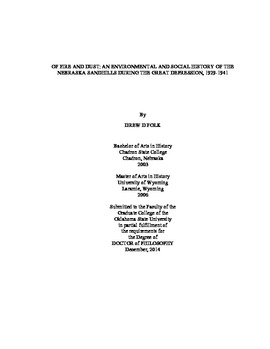| dc.description.abstract | During the Great Depression life on the Great Plains of the central United States was harsh, difficult, fiscally challenging, and, at times, deadly. The economic challenges posed to the region's agricultural residents was due largely to difficult environmental conditions, such as drought, dust storms, severe thunderstorms, pestilential plagues, and fire, which resulted directly in farm foreclosures and forced migration when successive years of failed crops and dry, dusty fields led to even dustier pockets. Past historiography has primarily focused on the difficult experiences of agriculturalists in the central and southern plains states with the northern plains states, especially Nebraska, receiving little scholarly discussion. Individuals who lived in the unique sub-region of Nebraska known as the Sandhills during the Great Depression shared the aforementioned environmental calamities to varying degrees with their neighbors on the central and southern plains; however, not all of their experiences were identical. Due to the sub-region's sandy soils, topography, and abundant rangelands Sandhills' agriculturalists utilized more pastoral methods than many of their Great Plains contemporaries, thus, in turn, leading to different forms of agrarian success and failure. "Frontier" aspects persisted in Sandhills society during the Depression era as roads were rudimentary, ranches and farms lacked electricity, horses remained essential to agricultural production as tractors were few and ill-suited to the Sandhills' terrain, and felonious crimes reminiscent of the stereotypical "Wild West," such as bank robberies and shootouts, were commonplace. This study examines how the Great Depression era was simultaneously Sandhills' society's most "frontier" period, due to these aspects, and it's most progressive one due to significant infrastructure improvements brought to the hills by the New Deal in the form of new roads, schools, and reclamation projects and the subsequent social issues that arose when these two differing societal points collided. | |
